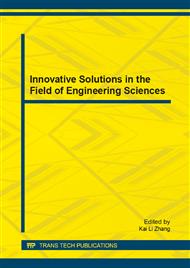[1]
A. Ross and A.K. Jain, Multimodal biometrics: an overview, Proceedings of 12th European Signal Processing Conference, p.1221—1224, (2004).
Google Scholar
[2]
J. Peng, C. Barbu, G. Seetharaman, W. Fan, X. Wu, and K. Palaniappan, Shareboost: Boosting for multi-view learning with performance guarantees, in Proceedings of ECML, 2011, pp.597-612.
DOI: 10.1007/978-3-642-23783-6_38
Google Scholar
[3]
J. Kittler, Combining classifiers: A theoretical framework, Pattern Analysis and Applications, vol. 1, p.18—27, (1998).
Google Scholar
[4]
L.I. Kuncheva, J.C. Bezdek, and R.P.W. Duin, Decision templates for multiple classifier fusion: An experimental comparison, Pattern Recognition, vol. 34, p.299—314, (2001).
DOI: 10.1016/s0031-3203(99)00223-x
Google Scholar
[5]
L.I. Kuncheva, A theoretical study on six classifier fusion strategies, IEEE Transactions on Pattern Analysis and Machine Intelligence, vol. 24, no. 2, pp.281-286, (1997).
DOI: 10.1109/34.982906
Google Scholar
[6]
L.I. Kuncheva, C.J. Whitaker, C.A. Shipp, and R.P.W. Duin, Is independence good for combining classifiers?, Proceedings of the 15th International Conference on Pattern Recognition, vol. 2, pp.168-171, (2000).
DOI: 10.1109/icpr.2000.906041
Google Scholar
[7]
S. Sonnenburg, G. Ratsch, C. Schafer, and B. Scholkopf, Large scale multiple kernel learning, Journal of Machine Learning Research, vol. 7, pp.1531-1565, (2006).
Google Scholar
[8]
P. Auer, N. Cesa-Bianchi, and P. Fischer, Finite-time analysis of the multi-armed bandit problem, Machine Learning, vol. 47, p.235—256, (2002).
DOI: 10.1023/a:1013689704352
Google Scholar
[9]
P. Auer, N. Cesa-Bianchi, Y. Freund, and R. Schapire, The non-stochastic multi-armed bandit problem, SIAM Journal on Computing, vol. 32, no. 1, pp.48-77, (2002).
DOI: 10.1137/s0097539701398375
Google Scholar
[10]
R. Busa-Fekete and B. Kegl, Accelerating adaboost using ucb, in KDDCup (JMLR W&CP), 2009, pp.111-122.
Google Scholar
[11]
F.D. Mesmay, A. Rimmel, Y. Voronenko, and M. Puschel, Bandit-based optimization on graphs with application to library performance tuning, in Proceedings of International Conference on Machine Learning, 2009, p.729—736.
DOI: 10.1145/1553374.1553468
Google Scholar
[12]
J. Maturana, A. Fialho, F. Saubion, M. Schoenauer, and M. Sebag, Extreme compass and dynamic multi-armed bandits for adaptive operator selection, In Proceedings of IEEE ICEC}, 2009, pp.365-372.
DOI: 10.1109/cec.2009.4982970
Google Scholar
[13]
J.Y. Audibert, R. Munos, and C. Szepesvari, Exploration-exploitation tradeoff using variance estimates in multi-armed bandits, Theor. Comput. Sci., vol. 410, no. 19, p.1876—1902, (2009).
DOI: 10.1016/j.tcs.2009.01.016
Google Scholar
[14]
R. Busa-Fekete and B. Kegl, Fast boosting using adversarial bandits, in Proceedings of International Conference on Machine Learning, (2010).
Google Scholar
[15]
H. Robbins, Some aspects of the sequential design of experiments, Bulletin American Mathematical Society, vol. 55, p.527—535, (1952).
DOI: 10.1090/s0002-9904-1952-09620-8
Google Scholar
[16]
N. Cesa-Bianchi and G. Lugosi, Prediction, Learning, and Games. Cambridge University Press, (2006).
Google Scholar
[17]
C. Rudin, R. Schapire, and I. Daubechies, Precise statements of convergence for adaboost and arc-gv, Contemporary Mathematics, vol. 443, (2007).
DOI: 10.1090/conm/443/08559
Google Scholar
[18]
R.E. Schapire and Y. Singer, Improved boosting algorithms using confidence rated predictions, Machine Learning, vol. 3, no. 37, p.297—336, (1999).
DOI: 10.1145/279943.279960
Google Scholar
[19]
S.S.S. Crihalmeanu, A. Ross, and L. Hornak, "A protocol for multi-biometric data acquisition, storage and dissemination. Technical Report, Lane Department of Computer Science and Electrical Engineering, West Virginia University, (2007).
Google Scholar
[20]
L. Masek and P. Kovesi, MATLAB source code for biometric identification system based on iris patterns. Technical Report, University of Western Australia, (2003).
Google Scholar
[21]
H.W. Mewes, et al. Mips: a database for genomes and protein sequences, Nucleic Acids Research, vol. 28, no. 1, p.37—40, (2000).
DOI: 10.1093/nar/28.1.37
Google Scholar


